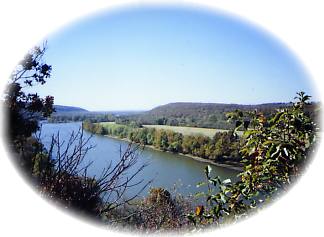
Beginning in the early 1920s, local residents sought to preserve Fort Gibson's History. In 1936, the stockade area was reconstructed by the Federal Emergency Relief Administration, Works Progress Administration, and the Fort Gibson Stockade Commission. Today, the Site is a National Historic Landmark, operated by the Oklahoma Historical Society.
33 sites are mapped for a fort tour aided by uniformed guides that add historical relevance to the specific points of interest. Throughout the year, reenactments, living history celebrations, and work shops fill the entire year with activity at the fort. (See the Calendar of Events for event descriptions).
Some of the sites on the Fort grounds include:
| The Commissary was built in 1845. It has undergone reconstruction, and is now the Visitor Center for the Fort Gibson Historic Site.
The Barracks building was constructed initially during the 1840s, but was not finished until after the Civil War. OnceHeadquarters for both the Ninth and Tenth Infantry, the Barracks building today is open for tours.
The Adair Cabin was relocated to its present site by the Muskogee County Historical Society. This dogtrot cabin once belonged to Judge Adair, and is said to have been used as a hospital during the Civil War.
The bakery, seen here, was in ruins before it was reconstructed by the Oklahoma Historical Society. The bakery is now used for public baking demonstrations, and is open to the public for tours.
The dogtrot is part of the 1936 WPA Stockade reconstruction. Today, it is used extensively for living history and reenactments, with many participants having slept in the cabin. When not in use for events, the building is accessible for visitors to the site.
The library and mess hall are also part of the reconstructed stockade. They too are accessible to visitors when not in use for events.
Within the reconstructed stockade, several rooms are set with displays, which show an officer's quarters, circa 1836. | 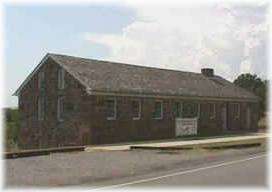 |
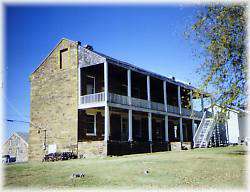 | |
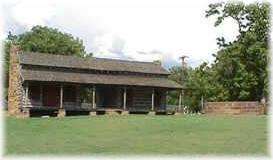 | |
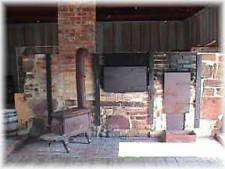 | |
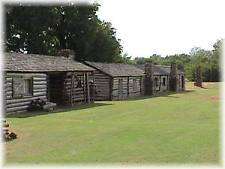 |
Brief History of Fort Gibson .....
In 1824, increasing tensions between the Cherokee and Osage Nations led the U.S. Army to relocate its westernmost presence from Fort Smith, Arkansas to a point farther west in the Arkansas territory. Colonel William Arbuckle selected a spot on the Grand River, three miles upstream form the convergence of the Arkansas, Grand and Verdigris Rivers.
Colonel Arbuckle oversaw the construction of a wooden stockade named Cantonment Gibson in honor of General George Gibson. The stability of the stockade encouraged both Euro and Native Americans to settle near the post giving rise to the community at Fort Gibson, the oldest in the state of Oklahoma.
The Seventh Infantry arrived at the post in 1831, and in 1832, Cantonment Gibson was renamed Fort Gibson. Soldiers at the fort were instrumental in overseeing the resettlement of the eastern tribes to Indian Territory. For many, Fort Gibson was the terminus of Native Americans and their African-American slaves after their removal from the southeast part of the nation, commonly known as the Trail of Tears.
In 1857, The Army withdrew from Fort Gibson and transferred the land and the buildings to the Cherokee Nation. During the Civil War the Confederate soldiers briefly occupied the site before establishing Fort Davis nearby. Fort Gibson was reactivated in 1863 and occupied by federal troops as a key point in controlling Indian Territory and the Texas Road. The U.S. 10th Cavalry, a unit of black soldiers nicknamed "Buffalo Soldiers," was stationed here after the Civil War. Fort Gibson also was the home of the first black regiment in Indian Territory, the 1st Kansas Colored Volunteers Infantry.
The Army served at the fort until 1871 when most troops were reassigned and the fort designated a commissary supply post. In 1872, following the arrival of the railroad to Indian Territory, the fort was reactivated to ensure law and order. In 1890, the Army abandoned Fort Gibson permanently.
